
Santalum acuminatum, the desert quandong, is a hemiparasitic plant in the sandalwood family, Santalaceae, which is widely dispersed throughout the central deserts and southern areas of Australia. The species, especially its edible fruit, is also commonly referred to as quandong or native peach. The use of the fruit as an exotic flavouring, one of the best known bush tucker, has led to the attempted domestication of the species.

Acacia cultriformis, known as the knife-leaf wattle, dogtooth wattle, half-moon wattle or golden-glow wattle, is a perennial tree or shrub of the genus Acacia native to Australia. It is widely cultivated, and has been found to have naturalised in Asia, Africa, North America, New Zealand and South America. A. cultriformis grows to a height of about 4 m (13 ft) and has triangle-shaped phyllodes. The yellow flowers appear from August to November in its natural range. Its attractive foliage and bright flowers make it a popular garden plant.

Acacia pycnantha, most commonly known as the golden wattle, is a tree of the family Fabaceae. It grows to a height of 8 metres and has phyllodes instead of true leaves. The profuse fragrant, golden flowers appear in late winter and spring, followed by long seed pods. Explorer Thomas Mitchell collected the type specimen, from which George Bentham wrote the species description in 1842. The species is native to southeastern Australia as an understorey plant in eucalyptus forest. Plants are cross-pollinated by several species of honeyeater and thornbill, which visit nectaries on the phyllodes and brush against flowers, transferring pollen between them.

Macrozamia is a genus of around forty species of cycads, family Zamiaceae, all of which are endemic to Australia. Many parts of the plant have been utilised for food and material, most of which is toxic if not processed correctly.

Haloragaceae is a eudicot flowering plant family in the order Saxifragales, based on the phylogenetic APG system. In the Cronquist system, it was included in the order Haloragales.

Lambertia is a genus of flowering plants, belonging to the family Proteaceae. It is endemic to Australia. The genus was named in 1798 by Sir James Edward Smith in honour of English botanist Aylmer Bourke Lambert.

Aphanopetalum is a genus of twining shrubs or vines in the family Aphanopetalaceae which are endemic to Australia.

The flora of Australia comprises a vast assemblage of plant species estimated to over 21,000 vascular and 14,000 non-vascular plants, 250,000 species of fungi and over 3,000 lichens. The flora has strong affinities with the flora of Gondwana, and below the family level has a highly endemic angiosperm flora whose diversity was shaped by the effects of continental drift and climate change since the Cretaceous. Prominent features of the Australian flora are adaptations to aridity and fire which include scleromorphy and serotiny. These adaptations are common in species from the large and well-known families Proteaceae (Banksia), Myrtaceae, and Fabaceae.

The flora of Western Australia comprises 10,551 published native vascular plant species and a further 1,131 unpublished species. They occur within 1,543 genera from 211 families; there are also 1,317 naturalised alien or invasive plant species more commonly known as weeds. There are an estimated 150,000 cryptogam species or nonvascular plants which include lichens, and fungi although only 1,786 species have been published, with 948 algae and 672 lichen the majority.
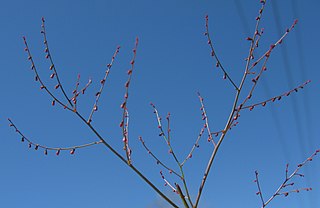
Gonocarpus (raspwort) is a genus of flowering plants in the family Haloragaceae. The species, which are native to Australia, New Zealand and Malesia, include:
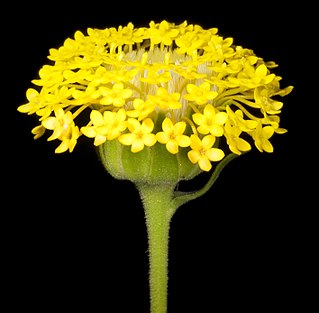
Podotheca is a genus of flowering plants in the tribe Gnaphalieae within the family Asteraceae. All species are endemic to Western Australia, except for Podotheca angustifolia which occurs across the south of Australia.
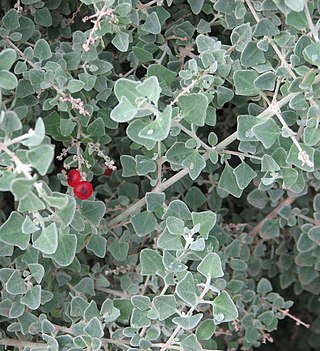
Chenopodium curvispicatum is a species of plant in the family Amaranthaceae, endemic to Australia.
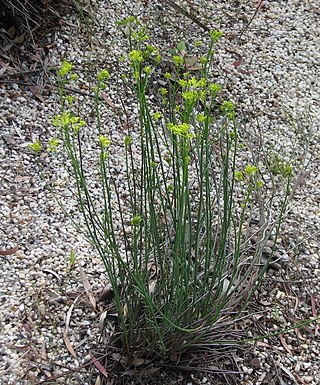
Glischrocaryon behrii, or golden pennants, is a perennial herb, native to southeastern Australia. The 5 to 6 inflorescences that appear in spring each comprise 7 to 60 yellow flowers.
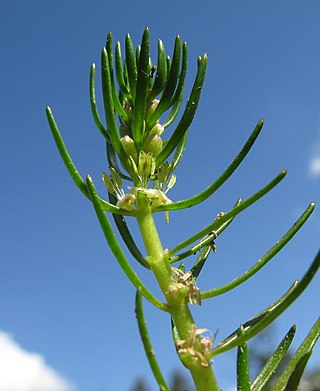
Myriophyllum variifolium is a species of water milfoil native to eastern Australia where it grows in aquatic habitat such as ponds and streams.

Gonocarpus micranthus commonly called creeping raspwort is a prostrate, ascending or erect perennial herb in the family Haloragaceae. It is native to Australia, New Zealand, New Guinea, South-east Asia, Japan and the Himalaya.
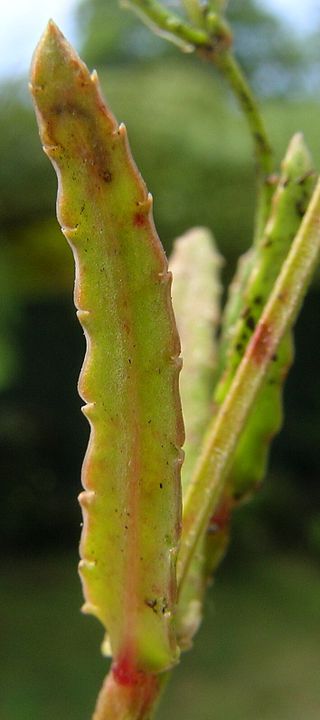
Gonocarpus chinensis is an accepted Australian shrub in the family Haloragaceae (watermilfoil) native to eastern Australia, South China, Caroline islands and North Australia. It was introduced to the Hawaiian islands, United States and California, United States. G. chinensis is considered not to be a economically impotent genus but can be used for medicine and gardening as ornamental plants. This species lives in wet tropical regions, grasslands, riverbanks and in waste lands in elevations at 100 to 800 meters but at 1800 meters in Southwest China.
Glischrocaryon flavescens is a perennial herb with woody roots that occurs in southern and western Australia.

Gonocarpus teucrioides, or forest raspwort is a common flowering herb or subshrub in the Haloragaceae, or watermilfoil family. It is native to Queensland, New South Wales, Victoria and Tasmania and is widespread and abundant in the understorey of wet forests. The name raspwort refers to the rough, scabrous surface of many of the Gonocarpus species.

Myriophyllum implicatum is a species of water milfoil in the family Haloragaceae. It is native to north-eastern Australia.

Gonocarpus elatus is a plant in the watermilfoil family Haloragaceae native to Australia, and found in New South Wales, Queensland, Victoria, and South Australia.



















